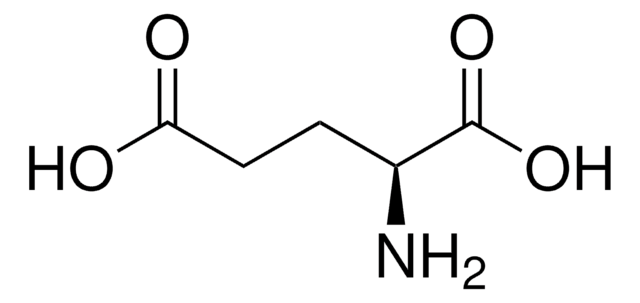If this product has an expiration or retest date, it will be shown on the Certificate of Analysis (COA, CofA). If there is no retest or expiration date listed on the product's COA, we do not have suitable stability data to determine a shelf life. For these products, the only date on the COA will be the release date; a retest, expiration, or use-by-date will not be displayed.
For all products, we recommend handling per defined conditions as printed in our product literature and website product descriptions. We recommend that products should be routinely inspected by customers to ensure they perform as expected.
For products without retest or expiration dates, our standard warranty of 1 year from the date of shipment is applicable.
For more information, please refer to the Product Dating Information document: https://www.sigmaaldrich.com/deepweb/assets/sigmaaldrich/marketing/global/documents/418/501/product-dating-information-06-25-mk.pdf
Select a Size
$34.20
$52.70
$206.00
$34.20
Available to ship TODAYDetails
About This Item
Skip To
Product Name
L-Glutamic acid, from non-animal source, meets EP testing specifications, suitable for cell culture, 98.5-100.5%
biological source
non-animal source
agency
meets EP testing specifications
assay
98.5-100.5%
form
powder
technique(s)
cell culture | mammalian: suitable
impurities
endotoxin, tested
color
white
mp
205 °C (dec.) (lit.)
solubility
1 M HCl: 100 mg/mL
density
1.54 g/cm3 at 20 °C
anion traces
chloride (Cl-): ≤200 ppm
sulfate (SO42-): ≤200 ppm
cation traces
As: ≤1 ppm, passes test
Fe: ≤10 ppm, passes test
NH4+: ≤200 ppm, passes test
application(s)
pharmaceutical (small molecule)
SMILES string
N[C@@H](CCC(O)=O)C(O)=O
InChI
1S/C5H9NO4/c6-3(5(9)10)1-2-4(7)8/h3H,1-2,6H2,(H,7,8)(H,9,10)/t3-/m0/s1
InChI key
WHUUTDBJXJRKMK-VKHMYHEASA-N
Gene Information
human ... CCR2(1231), GRIA1(2890), GRIA2(2891), GRIA4(2893), GRIK1(2897), GRIK2(2898), GRIK3(2899), GRIK5(2901), GRIN2B(2904), GRM2(2912), SLC1A1(6505), SLC1A2(6506)
rat ... Gria1(50592), Grik1(29559), Grik2(54257), Grik4(24406), Grin2a(24409), Grm1(24414), Grm2(24415), Grm3(24416), Grm4(24417), Grm5(24418), Grm6(24419), Grm7(81672), Slc1a2(29482)
Looking for similar products? Visit Product Comparison Guide
Related Categories
1 of 4
This Item | 49449 | G1251 | G0355000 |
|---|---|---|---|
| form powder | form powder | form powder | form - |
| assay 98.5-100.5% | assay ≥99.5% (NT) | assay ≥99% (HPLC) | assay - |
| technique(s) cell culture | mammalian: suitable | technique(s) - | technique(s) microbiological culture: suitable | technique(s) - |
| mp 205 °C (dec.) (lit.) | mp 205 °C (dec.) (lit.) | mp 205 °C (dec.) (lit.) | mp 205 °C (dec.) (lit.) |
| color white | color white | color white to off-white | color - |
| solubility 1 M HCl: 100 mg/mL | solubility 1 M HCl: 1 M at 20 °C, clear, colorless | solubility 1 M HCl: soluble 100 mg/mL | solubility - |
Application
Biochem/physiol Actions
used together
Storage Class
11 - Combustible Solids
wgk_germany
WGK 1
flash_point_f
Not applicable
flash_point_c
Not applicable
ppe
Eyeshields, Gloves, type N95 (US)
Choose from one of the most recent versions:
Already Own This Product?
Find documentation for the products that you have recently purchased in the Document Library.
guidance
Articles
Sigma article discusses tumor cell metabolic pathways, focusing on aerobic glycolysis and mitochondrial activity.
Chromatograms
-
How can I determine the shelf life / expiration / retest date of this product?
1 answer-
Helpful?
-
-
How is shipping temperature determined? And how is it related to the product storage temperature?
1 answer-
Products may be shipped at a different temperature than the recommended long-term storage temperature. If the product quality is sensitive to short-term exposure to conditions other than the recommended long-term storage, it will be shipped on wet or dry-ice. If the product quality is NOT affected by short-term exposure to conditions other than the recommended long-term storage, it will be shipped at ambient temperature. As shipping routes are configured for minimum transit times, shipping at ambient temperature helps control shipping costs for our customers. For more information, please refer to the Storage and Transport Conditions document: https://www.sigmaaldrich.com/deepweb/assets/sigmaaldrich/marketing/global/documents/316/622/storage-transport-conditions-mk.pdf
Helpful?
-
-
I have to do a solution 147,13mg/ml Can I frooze aliquot of this solution?
1 answer-
Unfortunately, information regarding the solution stability of Product G8415, L-Glutamic acid is not determined. It is recommended to dissolve the product and use freshly prepared dilutions.
Helpful?
-
Active Filters
Our team of scientists has experience in all areas of research including Life Science, Material Science, Chemical Synthesis, Chromatography, Analytical and many others.
Contact Technical Service